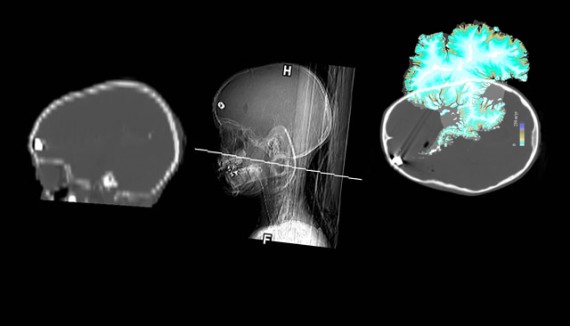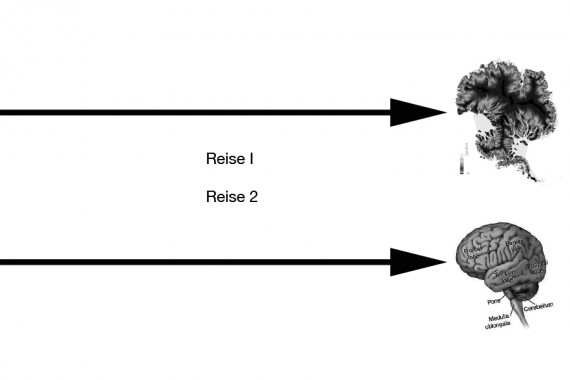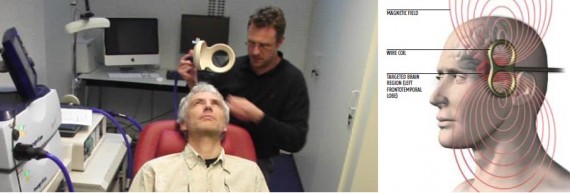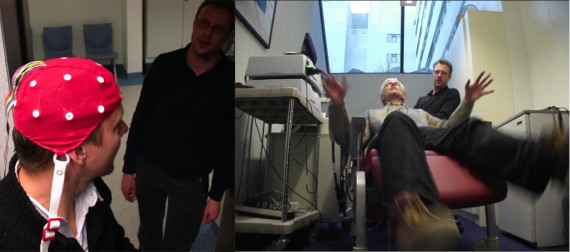a Self
22. 6. 2011 // Eric Joris // Kategorie Randnotizen 2011
Neuroscience is rapidly building up alternative theories about conscience, about the self.
With Stef De Paepe and Peter Verhelst I went regularly seeing neuroscientists. We have a steady interest from their community as well, since our immersive configurations may be putting into practice some of the new theories.
So Phantoms of the brain of Villayanur Ramachandran was a while like a bible to us.
The Egotunnel of neurophilosopher Thomas Metzinger takes the view of a phantom world even further.
A plant does not need a brain. But the highly mobile organism we are needs fast information and needs accurate predictions of what is going on around. For Metzinger there is no direct connection between the self and the outer world. What we perceive is virtual: by using the senses and our body as an interface, the brain makes a simulation of the outer world. The simulation is so perfect that we are not aware that it only is an image in our head. An image which is being modeled by an interface, being our own body.
An interface which has become transparant, invisible. And which produces a feeling of reality which becomes the self, the ego.
Were used to thinking about the self as an independent entity, something that we either have or are. In The Ego Tunnel, philosopher Thomas Metzinger claims otherwise: No such thing as a self exists. The conscious self is the content of a model created by our brain an internal image, but one we cannot experience as an image. Everything we experience is “a virtual self in a virtual reality.” But if the self is not “real,” why and how did it evolve? How does the brain construct it? Do we still have souls, free will, personal autonomy, or moral accountability? In a time when the science of cognition is becoming as controversial as evolution, The Ego Tunnel provides a stunningly original take on the mystery of the mind.
http://www.andyross.net/metzinger.htm
With the immersive configurations of CREW, we are partly able to construct an ego as Metzinger describes it.
Untill where can we get with this is the intruiging question aheadof us. Where could be the ultimate point of these uncharted territories?
The implications of Ramachandran’s studies appear radical. Not only do they help confirm the idea that the self consists of an illusion from the interactions of many brain functions, but that our spiritual feelings of God and our sense of certainty come from the brain’s temporal lobes. (Other scientists such as Paul Maclean and Michael Persinger had also observed that spiritual sensations or a sensed presence results from probing or stimulating the temporal lobes). According to Ramachandran, pain also comes as an illusion from a construction of the brain just as any other sensory experience. Even people with missing arms or legs can feel intense pain in their phantom limbs. It appears that our body image, our sense of self, pain and sensory experience consist of maps that help us survive in the world. Ramachandran suggests the possibility that “perhaps we are hallucinating all the time and what we call perception is arrived at by simply determining which hallucination best conforms to the current sensory input.”
http://www.nobeliefs.com/Ramachandran.htm
This is where Stef and I drew a parallel when writing the script of Terra Nova: a search for the absolute in the brain, and the quest for the last ultimate point on earth, by Scott.

The new theories seem to be reductionist at the expense of psychoanalysis. Or maybe quite at the contrary they are enriching existing hypothesizes. The cooperation with Peter, the writer of Terra Nova started right away at the cabinet of a neuropsychiatrist, Dr.Georges Otten (of the Guislain psychiatric hospital). We were fascinated by experiments which showed how social and responsible behaviour, feelings of justice a.o. can be triggered or leveled by stimulating particular neural circuits.
A technique to do this is Transcranial Magnetic Stimulation. Stef and I participated in some tests with TMS at the lab of Dr. Dirk De Ridder. Dirk De Ridder is a neurosurgeon who does implants for pain relief and uses TMS for treating tinutis.
By treating a particular patient, he could coin a region in the brain which generated out of body effects if being stimulated.
http://www.technologyreview.com/blog/editors/21907/
In our case only motoric functions were heavily influenced :-).
By the way, Dirk De Ridder opposes Ramachandrans hypothesis about the God-circuit, and certainly so for the theory and use of it of Michael Persinger.




